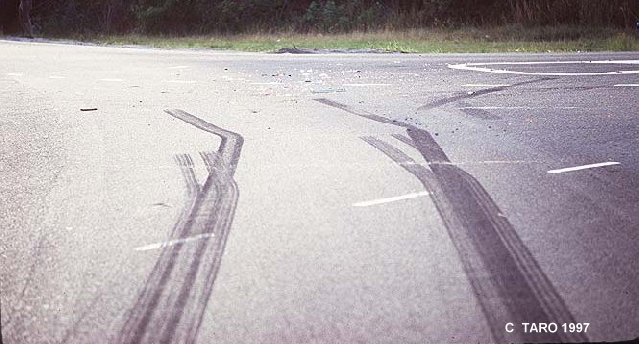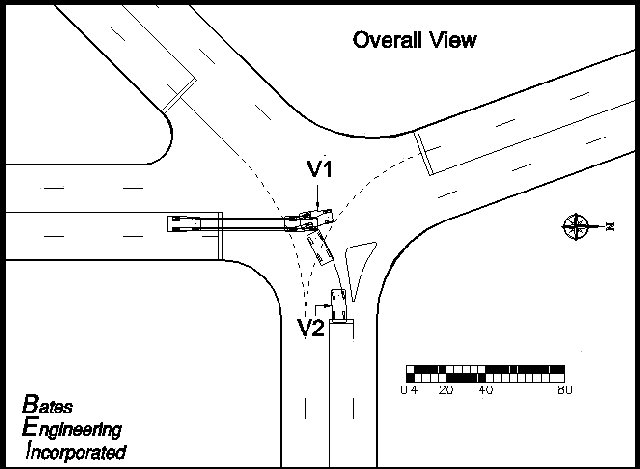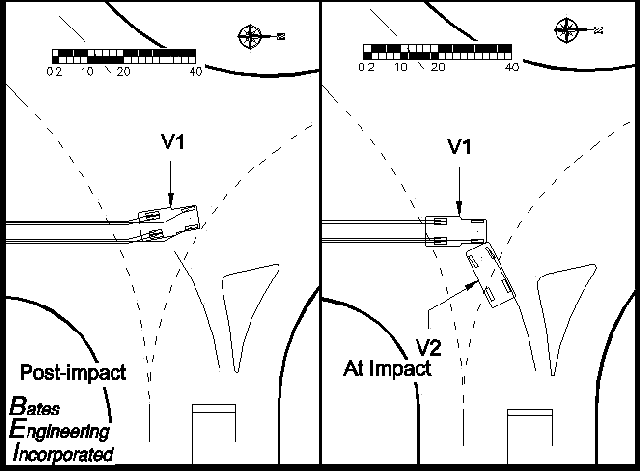
The Traffic Accident Reconstruction Origin -Approach Angles Solution-
|

|
[Home]
[ARnews]
[Contents]
[Classified]
[Advertisers]
[Approach Angles]
[E-mail Directory]
[Feedback]
[Organizations]
[Reference Library]
WHAT CAN A PHOTOGRAPH REVEAL?
By John T. Bates
ASSIGNMENT: What information can be derived from studying the photograph provided
by TARO Approach Angles entitled Tiremarks?

For orientation purposes, assume that the top of the photograph is north. Also, assume
the vehicle heading northbound is vehicle 1 and the other vehicle is vehicle 2.
CONCLUSIONS:
There are many conclusions which can be derived from carefully studying this one
photograph. A computer generated drawing showing the overall view of the intersection,
the vehicles at impact and the skidmarks follows to illustrate these conclusions.

- The Street Configuration - the first task is to determine the geometric
design of the intersection. Without an understanding of the configuration of the intersection,
it would be difficult to comprehend the actions of the vehicles:
- The dashed white stripes running from near the upper left corner of the photograph toward
the upper right corner indicate the guide line for southbound left turn traffic intending
to go eastbound.
- The dashed white stripes in the foreground commencing near the lower left corner of
the photograph and continuing to the mid-point along the right side of the photograph
probably indicate the guide line for movement of the eastbound traffic entering the
intersection from the southwest approach crossing the intersection to continue
eastbound.
- Therefore, the northbound street curves to the northwest in the intersection. The
westbound street curves to the southwest in the intersection.
- At the east approach of the intersection, there is also a painted island in the upper
right corner of the photograph separating the westbound through traffic from the westbound
right turn traffic intending to proceed northbound in a northwesterly direction.
- The photograph does not reveal any traffic control signs for the intersection.
- The tiremarks from vehicle 1 are far enough to the west to indicate that there is another
northbound lane to the right of vehicle 1. Therefore, the north-south street is probably at
least a four lane street.
- Analysis of Vehicle 1
- the next task is to study what the tiremarks tell us about
each vehicle:
- Vehicle 1 skidded prior to colliding with vehicle 2.
- All wheels of vehicle 1 continued to skid after the collision. This fact indicates that
the driver's foot for vehicle 1 remained on the brake pedal after the collision and continued
to brake until the vehicle came to a stop. That conclusion might lead to a subsequent
conclusion that the collision was not one of a major impact, or the driver's foot would
have likely been knocked off the brake pedal.
- Vehicle 1 was northbound (going away from the photographer) prior to the accident.
The reason is that the axle which went further to the north has single tires which would
indicate the front of the vehicle. That conclusion is based on the fact that the skids of
only one tire on each side of the vehicle is shown in the photograph beyond the point of
impact.
- Vehicle 1 is probably a two axle six wheel truck. The rear wheels are definitely duals
but the tiremarks from a third axle cannot be discerned.
- The left front tire is under-inflated because the outside and inside edges of the tire
mark are dark and the middle of the tire mark is lighter. This indicates that the bottom of
the tire was humped up in the middle due to inadequate tire pressure.
- All other tires appear to be properly inflated.
- The load on the truck must have been unevenly distributed with the right front tire
being loaded more than usual because the pre-impact skid mark from that tire is much heavier
than would otherwise be expected; that is, that tire was supporting more weight than its
normal share.
- A collision occurred.
- The point of impact is approximately where the skid marks from vehicle 1 deflected to
its left. The initial contact point on vehicle 1 was the right portion of the front of the
vehicle because the deflection in the direction of the skids of vehicle 1 occurs when vehicle
1 is at that location.
- The initial contact point on the right side of the front of vehicle 1 not only caused
vehicle 1 to deflect to the northwest but also to rotate slightly in a counterclockwise
direction as evidenced by the skid marks of the rear duals not deflecting at the same angle
nor deflecting as far to the west as the fronts.
- Vehicle 1 came to rest after the collision in about the length of that vehicle's wheelbase
length because the rear tires came to rest at approximately the location where the front tires
deflected to the northwest, due to the collision.
- Since the skid marks for vehicle 1 originate to the south of the bottom of the photograph,
no determination can be made as to the length of the skid marks and, therefore, no
determination can be made about the initial speed of vehicle 1 prior to braking.
- Vehicle 1 traveled a much further distance into the intersection prior to colliding with
vehicle 2 than vehicle 2 did. Therefore, vehicle 1 probably entered the intersection
first.

- Analysis of Vehicle 2:
- Vehicle 2 skidded prior to colliding with vehicle 1 because the skid mark of at
least the right front tire can be seen in the photograph.
- The brakes of vehicle 2 might be out of adjustment since it appears that only the
right front tire completely locked up.
- There is no evidence of post impact skidding from vehicle 2.
- The initial point of contact on vehicle 2 was the right portion of the front of the
vehicle.
- If north is 360 degree azimuth, the principal direction of force of vehicle 2 was
probably coming from a direction of about 45 degrees; that is, vehicle 2 collided with
vehicle 1 when vehicle 2 was going generally in a southwesterly direction.
- Vehicle 2 entered the intersection from a westbound direction and was in the process
of turning left to go south. This conclusion is based on the fact that the direction of
vehicle 2's skid mark is not parallel to the dashed white line in the foreground of the
photograph but rather is aimed in a direction to cross the dashed white line. If the tire
mark from vehicle 2 had been parallel to the dashed white line, vehicle 2 would have been
going westbound while curving to the southwest as the street turns that direction.
- Since vehicle 1 was redirected into a northwesterly direction and since there is no
scuff marks left from vehicle 2 on the pavement after the collision, vehicle 2 was probably
a heavier vehicle than vehicle 1 and perhaps traveling faster than vehicle 1 at impact.
This conclusion does not mean that vehicle 2 was going faster than vehicle 1 prior to
braking.
- Since there are no skid marks from other than the right front tire of vehicle 2,
there is no conclusive information as to the number of axles and tires that vehicle 2
had.
Biographical Sketch of the Author
John T. Bates, a Civil Engineer specializing in traffic accident
reconstruction, has analyzed over 3,000 accidents in 22 states during the past 26 years.
He received a Bachelor of Science in Civil Engineering degree from
the University of Texas at Austin in 1956. He is a Registered Professional Engineer and has
practiced engineering for over 40 years, including the design and supervision of construction
of streets, highways, bridges and traffic control devices. He is a member of numerous
professional engineering societies. He has taught part time at various colleges and
universities.
He has received specialized training in traffic accident reconstruction,
and holds a Certificate of Full Accreditation from the Accreditation Commission for Traffic
Accident Reconstructionists. He has authored or co-authored numerous articles on traffic
accident reconstruction.
Mr Bates can be reached at bei@theshop.net
[Home]
[ARnews]
[Contents]
[Classified]
[Advertisers]
[Approach Angles]
[E-mail Directory]
[Feedback]
[Organizations]
[Reference Library]






